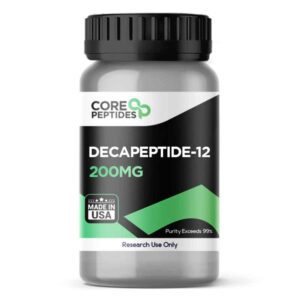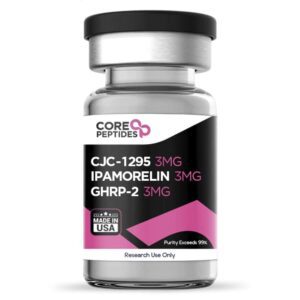Description
Nonapeptide-1 (Melanostatine-5) – Research Grade
Product Code: NP1-5MG
Size: 5 mg
Form: Lyophilized Powder
Purity: ≥99% (HPLC)
Molecular Formula: C₆₁H₈₇N₁₅O₉S
Molecular Weight: 1206.5 g/mol
Sequence: Met–Pro–D-Phe–Arg–D-Trp–Phe–Lys–Pro–Val–NH₂
Storage: –20°C (Stable for 24 months if unopened)
Solubility: Soluble in water, PBS, or dilute acetic acid
Description
Nonapeptide-1, also known as Melanostatine-5, is a synthetic peptide composed of nine amino acids. Initially identified in the 1990s through a peptide library screening of over 31,000 analogs, it emerged as one of the most potent melanocortin-1 receptor (MC1R) antagonists discovered (Jayawickreme et al., J. Biol. Chem., 1994).
MC1R plays a crucial role in melanogenesis, the process responsible for pigment formation in skin, hair, and eyes. Activation of this receptor by α-melanocyte-stimulating hormone (α-MSH) upregulates tyrosinase, TRP-1, and MITF, leading to increased melanin synthesis.
Research suggests that Nonapeptide-1 may competitively inhibit MC1R, potentially reducing α-MSH binding, thereby decreasing the downstream expression of tyrosinase and melanin production (Chen et al., Postepy Dermatol Alergol., 2022).
In vitro studies on melanocytes and keratinocytes indicate Nonapeptide-1’s ability to downregulate pigmentation pathways and potentially reduce melanin synthesis following UVA exposure. Clinical pilot studies also report visible improvements in skin tone and melasma index when Nonapeptide-1 is applied topically under controlled research conditions (Chatterjee et al., Indian J. Dermatol. Venereol. Leprol., 2021).
Beyond pigmentation, MC1R is expressed in neurons and immune cells, suggesting further investigative potential in inflammation, nociception, and melanocyte biology (Xia et al., Neuroreport, 1995).
Chemical Information
| Property | Value |
|---|---|
| Molecular Formula | C₆₁H₈₇N₁₅O₉S |
| Molecular Weight | 1206.5 g/mol |
| Sequence | Met–Pro–D-Phe–Arg–D-Trp–Phe–Lys–Pro–Val–NH₂ |
| Form | Lyophilized Powder |
| Solubility | Water, PBS, dilute acetic acid |
| Storage | –20°C (long-term) |
| Stability | Stable for 24 months under proper storage |
Certificate of Analysis (COA)
| Test | Specification | Result | Method |
|---|---|---|---|
| Appearance | White to off-white lyophilized powder | Pass | Visual |
| Identity | Conforms to Nonapeptide-1 sequence | Confirmed | MS |
| Purity (HPLC) | ≥99.0% | 99.42% | HPLC |
| Molecular Weight | 1206.5 ± 1.0 g/mol | 1206.6 g/mol | ESI-MS |
| Water Content | ≤6.0% | 4.8% | Karl Fischer |
| Acetic Acid Content | ≤10.0% | 8.2% | Titration |
| Peptide Content | ≥80% | 83.7% | UV 214 nm |
| Bacterial Endotoxins | <0.5 EU/mg | <0.5 EU/mg | LAL Test |
| Storage Condition | –20°C | Conforms | Verification |
HPLC Chromatogram (Representative Batch)
-
Column: C18 Reverse-Phase (4.6 × 250 mm, 5 µm)
-
Mobile Phase: A: 0.1% TFA in water / B: 0.1% TFA in acetonitrile
-
Gradient: 5–60% B over 30 min
-
Detection: 214 nm
-
Retention Time (Rt): 18.27 min
-
Purity: 99.42% (Area normalization)
(Figure 1: Representative chromatogram showing a single major peak corresponding to Nonapeptide-1 at Rt = 18.27 min with no detectable impurities >0.3% threshold.)
Mass Spectrometry (ESI-MS)
| Parameter | Value |
|---|---|
| Observed [M+H]+ | 1206.6 Da |
| Calculated [M+H]+ | 1206.5 Da |
| Mass Accuracy | ±0.1 Da |
| Result | Confirmed identity |
(Figure 2: Mass spectrum displaying the primary ion peak at m/z 1206.6, confirming molecular integrity and accurate synthesis.)
Research Applications
Nonapeptide-1 is currently being studied in the following research contexts:
-
Regulation of melanogenesis and pigmentation
-
MC1R receptor antagonism studies
-
UV-induced oxidative response in skin cells
-
Neuroinflammatory and nociceptive pathways
-
Melanoma cell signaling and tumor biology
Important Notice
This product is intended for research use only.
Not for human consumption, cosmetic, therapeutic, or diagnostic purposes.
Use only under qualified laboratory conditions in compliance with institutional biosafety standards.
References
-
Jayawickreme, C.K., et al. (1994). Discovery and structure-function analysis of alpha-melanocyte-stimulating hormone antagonists. J. Biol. Chem., 269(47): 29846–29854.
-
Gaston, L.S., & Majzoub, J.A. (2022). Adrenocorticotrophin. In The Pituitary, pp. 51–89.
-
Chen, J., et al. (2022). Effects of tea polyphenols on UVA-induced melanogenesis via inhibition of α-MSH-MC1R signaling pathway. Postepy Dermatol Alergol., 39(2): 327–335.
-
Chatterjee, M., et al. (2021). A randomized controlled pilot study of a proprietary combination versus sunscreen in melasma maintenance. Indian J. Dermatol. Venereol. Leprol., 88(1): 51–58.
-
Xia, Y., et al. (1995). Expression of melanocortin 1 receptor in periaqueductal gray matter. Neuroreport, 6(16): 2193–2196.
-
Delaney, A., et al. (2010). Involvement of melanocortin 1 receptor antagonists in inflammatory pain modulation. Eur. J. Neurosci., 31(10): 1895–1905.





Reviews
There are no reviews yet.